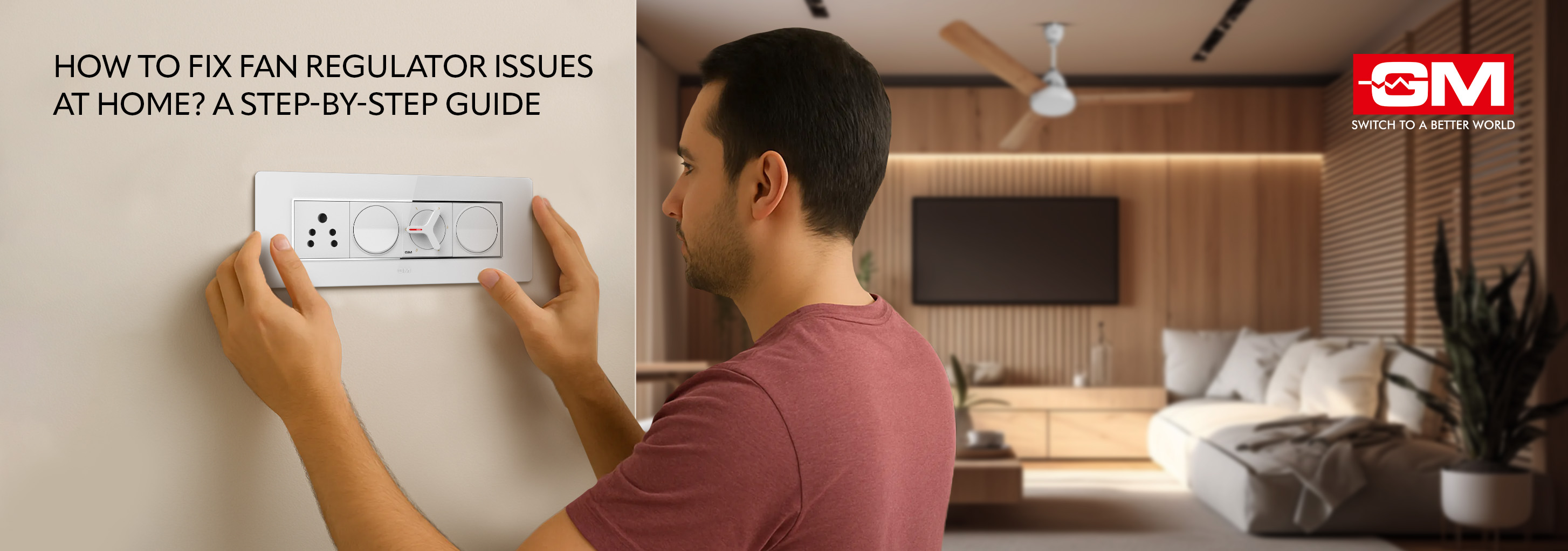Blog
How to Fix Fan Regulator Issues at Home: A Step-by-Step Guide
Updated on Jul 2025

A ceiling fan is a common appliance in every Indian home, and the ceiling fan regulator controls its speed. With heavy use, especially during summer, the regulator may stop working properly, leading to poor air circulation and discomfort.
This guide will show you simple ways to fix ceiling fan regulator problems at home, saving you time and money. But first, let’s explore common issues with fan regulators.
Potential Fan Regulator Issues
It is common for the ceiling fans at home to face the following problems requiring the repair process.
1. Fan not responding to speed changes, despite the speed setting. The underlying problem could be a faulty regulator or a loose wiring connection.
2. Fan running only at one high speed, indicating an underlying issue of the potentiometer malfunctioning.
3. Overheating of the ceiling fan regulator unit is evolving due to disproportionate current load, higher input voltage, or electrical faults.
4. Constant buzzing or humming noise while the fan operates. Generally, this problem results from the wear and tear of the fan components.
5. Visible damage that makes the fan inoperative. However, flawed or damaged wiring between the regulator and the fan’s main motor connection can also be the cause for the fan not turning on.
6. Burnt smell or visible sparks from the regulator, indicating a potential fire hazard and putting everyone’s lives at risk.
Tools Required for Fan Regulator Repair
Tools Needed to Fix a Fan Regulator at Home:
-
Screwdriver
-
Voltage tester or multimeter
-
Insulated gloves
-
Wire stripper (if required)
-
New GM fan regulator (if replacing the old one)
Step-by-Step Guide to Fix Fan Regulator Issues
Here is a detailed process you should follow to repair a fan regulator at home.
1. Turn Off the Power Supply
Switch off the circuit breaker for the fan. Use a tester to ensure there’s no power in the wires.
2. Remove the Fan Regulator Cover
Use a screwdriver to remove the faceplate. The regulator is usually held in place with 2-4 screws.
3. Inspect the Regulator for Damage
Look for burn marks, cracks, or melted parts. If damaged, replace the regulator.
4. Disconnect the Old Regulator
Unscrew the wires from the regulator. Double-check with a voltage tester, and make note of how the wires are connected.
5. Test the Regulator and Components
Check the capacitor and potentiometer for damage. Use a multimeter to test resistance across the terminals. If no resistance or infinite resistance is detected, replace the regulator.
6. Inspect the Wiring Setup
If the regulator looks fine, check for any damaged or loose wiring that may be causing the issue.
7. Install the New Regulator
If the old regulator is damaged, replace it with a new one. Connect the wires to the same terminals and tighten the screws.
8. Reattach the Cover Plate and Restore Power
Reattach the faceplate, turn the power back on, and test the fan on different speed settings to confirm everything is working.
When Should You Call a Professional?
While many fan regulator issues can be fixed at home with basic tools, some situations require professional help:
-
If the fan doesn't work even after replacing the regulator.
-
If the regulator heats up immediately after installation.
-
If you're unsure about handling live electrical connections.
Preventive Tips to Avoid Fan Regulator Issues
Although you can repair or replace a damaged fan regulator at home, it's always better to prevent issues before they happen. Here are some simple tips:
1. Avoid Overloading
Don’t plug heavy electrical appliances into the same switchboard as the fan regulator. This can lead to overheating and damage.
2. Keep It Dust-Free
Dust can affect the internal components of the regulator. Clean the surface regularly to avoid buildup.
3. Watch for Flickering or Noise
Buzzing or flickering are early signs of a problem. Don’t ignore them—check the regulator or fan right away.
4. Use Branded Parts
Use high-quality, branded regulators for better performance and durability. Always rely on certified electricians for safe installation and repairs.
5. Apply Lubricant
Lubricate the fan’s motor and bearings from time to time. This reduces wear and lowers the strain on the regulator.
A faulty fan regulator can be both inconvenient and unsafe, especially during hot weather. Knowing how to fix minor problems at home gives you peace of mind. With the right tools and precautions, many issues can be solved without needing a professional.
If the problems keep recurring, consider upgrading to GM Modular fans, which are designed for safety, style, and long-lasting performance.
Also, if you are having trouble with your ceiling fan. Check out our blog on Common Ceiling Fan Problems & Tips to Fix Them.
Frequently Asked Questions
1. How to fix fan speed issues?
Clean the fan regulator and check for motor or capacitor problems. Replacing or cleaning the regulator often solves the issue.
2. Can a fan regulator be repaired?
Yes. Once you identify the problem, it can be fixed or replaced. Home repair is possible, but using an electrician adds safety.
3. How to check a ceiling fan capacitor?
Find the small black box inside the fan’s switch housing. If it smells burnt or looks melted, it's likely damaged.
4. Should I repair or replace a broken regulator?
Minor wiring faults can be repaired, but it's safer to replace a damaged regulator.
5. Can a bad regulator harm the fan?
Yes. A faulty regulator can cause voltage fluctuations that may damage the fan motor.
Related Blogs

Why GM Modular Wires & Cables Are the Smart Choice for Electrical Safety
When it is about electrical installations, wiring is the invisible backbone that supports everything from lighting to appliances, motors to smart home systems. A poor-quality wire can undermine even the best equipment, leading to voltage drops, overh
Read More
Ultimate Guide to Buying the Right Immersion Rod for Your Home
When it comes to quick, affordable, and efficient water heating, few appliances can match the simplicity and effectiveness of an immersion rod. From a chilly winter morning to a last-minute need for warm water, this compact device is one of the most
Read More
Types of LED Lights You Should Know Before Buying
Lighting has come a long way from the days of bulky bulbs and high electricity bills. Today, LED lights have transformed how we illuminate our homes, offices, and outdoor spaces, combining energy efficiency, style, and longevity in one smart package.
Read More
Top GM Modular Fans to Add Comfort & Style This Festive Season
A festive season is more than lights and decorations; it's about creating a warm, welcoming space. As families gather, meals linger, and laughter fills rooms, comfort becomes just as important as looks. Amid all the décor decisions, one o
Read More